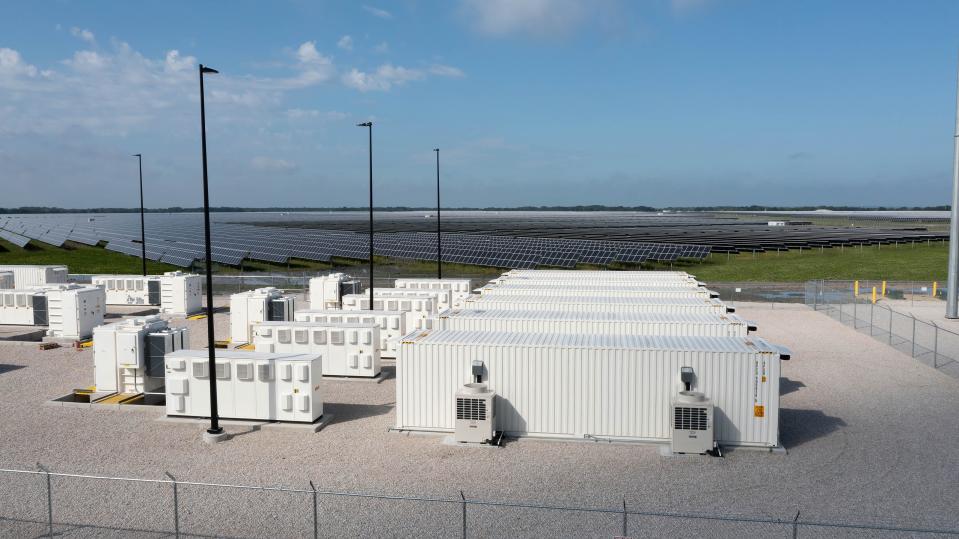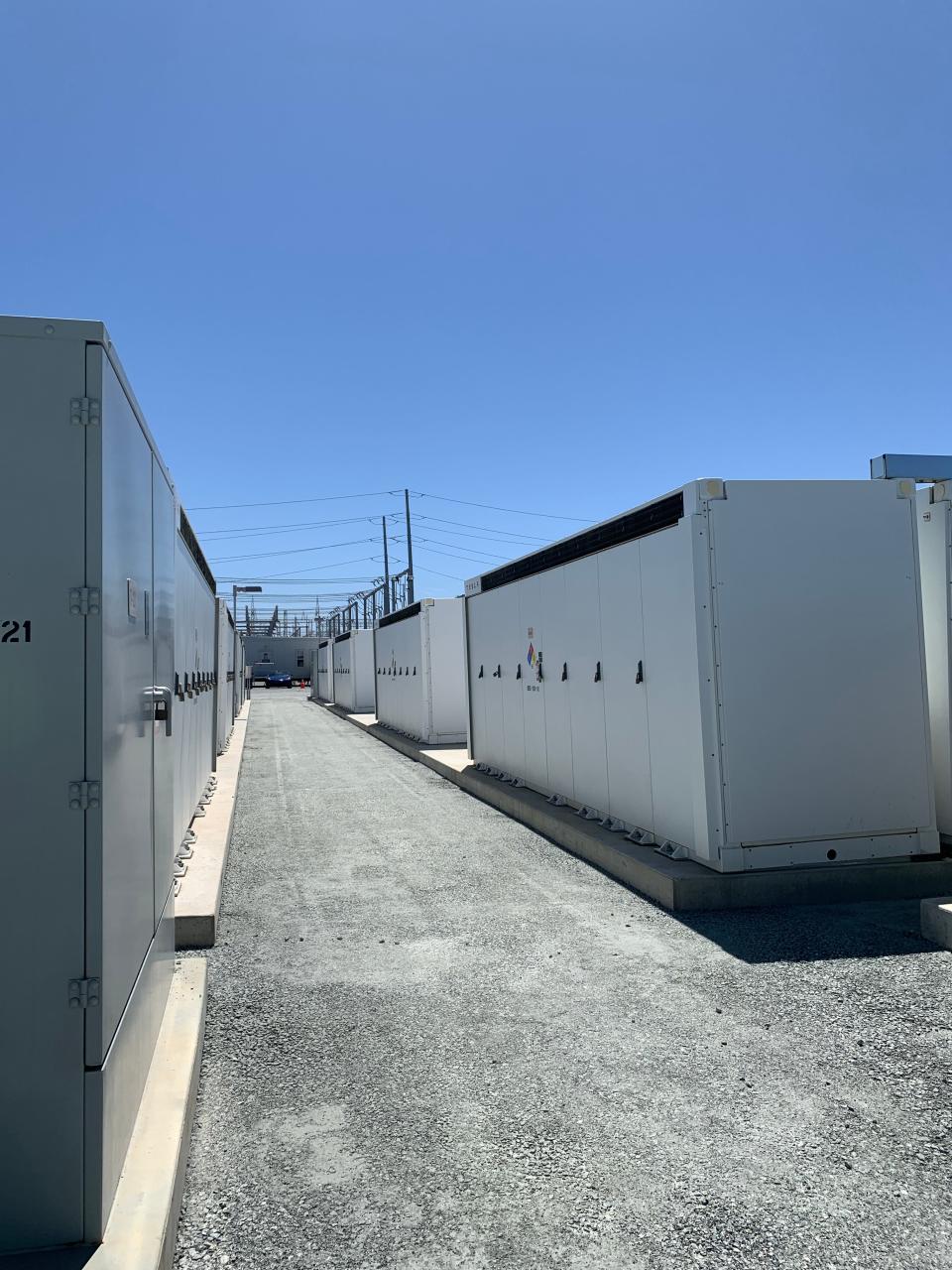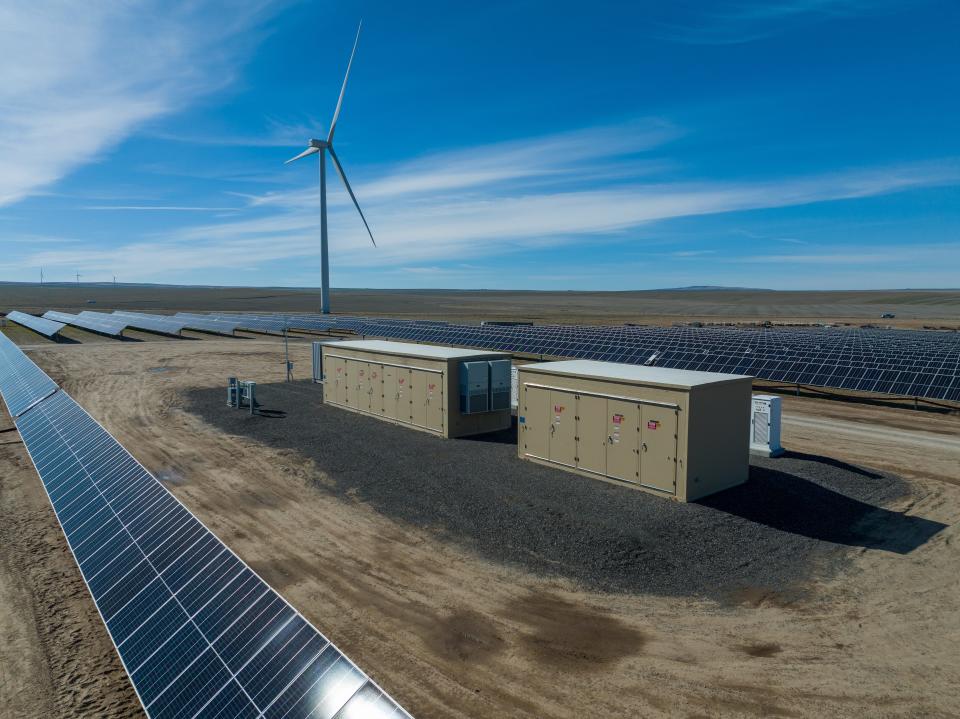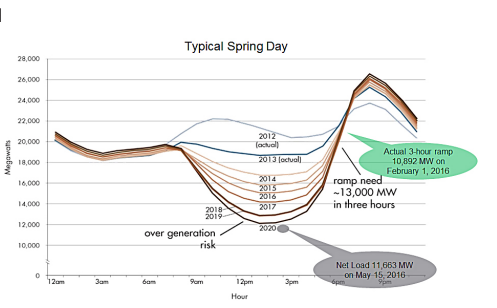Next step in combating climate change? Massive batteries that harness the power of the sun.

The US is making a big down payment on climate change. Here's what needs to come next.
MOSS LANDING, Calif. – Less than a mile from a sea otter-filled estuary popular with kayakers sit row upon row of tall, steel white cabinets perched on low concrete platforms, the space between them crisscrossed with gravel paths. All is quiet save for the faint occasional hum of fans and the cawing of seagulls overhead.
A passerby might mistake the place for a self-storage facility, but old furniture and keepsakes aren't kept here. The energy of the sun is.
All day long, electricity from solar arrays pours into the California electric grid, too much to be used in daylight hours when demand is lower. The excess is stored here, at Pacific Gas & Electric's 182.5-megawatt Moss Landing Elkhorn Battery System.
Once the site of the state's largest fossil fuel-fired power plant, Elkhorn is one of dozens of utility-scale lithium-ion battery systems around the country that feed renewable energy back to the grid when it's needed.
"This is a future beyond fossil fuels, a future of clean air and a stable climate," said David Hochschild, chair of the California Energy Commission.
Video: Biden signs executive order to tackle climate change on Earth Day
Called utility-grade batteries, Elkhorn's rows of white boxes can hold solar power for up to four hours. That helps cover the crucial window when the sun goes down, just as tens of millions of Californians come home, turn on their air conditioners and fire up their stoves to make dinner, a period called "the evening ramp."
Fully charged, the Elkhorn facility holds enough electricity for the instantaneous demands of PG&E customers in nearly 275,000 homes.
The storage allows the utility to avoid sourcing power from more expensive natural gas power plants needed only for peak demand. Just 10 days after the battery system was certified for operation, on April 17, it proved its worth.
"We were filling the batteries at a cost of $10 per megawatt hour. When we began to use that power at peak, it was worth $100 per megawatt hour," PG&E CEO Patti Poppe told a crowd at last week's unveiling of the system.

Over the course of this and last year, PG&E commissioned six large facilities in the state that together have the capacity to store nearly 1,000 megawatts of energy. It has contracts for another 2,374.5 megawatts through 2024.
PG&E also pulls power from an installation next door to Elkhorn owned by Vistra Corp. of Texas. It has a capacity of 400 megawatts and is scheduled to add another 350 megawatts in the coming years.
Last year California installed more than 2 gigawatts of battery storage, said Hochschild, and now has more than anywhere else in the world.
"It's an incredible success story," he said. "Clearly, we've entered a golden age of energy storage."
Storage is happening everywhere
Such battery sites are not unique to California. Eight states have set goals for energy storage to balance out wind- and solar-generated power, according to the American Clean Power Association, and more are expected to do the same as prices fall.
Without the ability to store energy, solar power isn't as useful as it might be. And as more renewable energy is added to the nation's electric grid the need for storage is growing.

In Oregon, the Wheatridge Renewable Energy Facility, owned by Portland General Electric, features a 30-megawatt battery set connected to a 350-megawatt wind and solar installation.
Florida Power & Light Company is building a 409-megawatt solar-powered battery storage facility, "enough to power Disney World for approximately seven hours," the company said.
The battery facility, under construction at the Manatee Energy Storage Center in Parrish, Florida, has enough capacity to power approximately 329,000 homes for more than two hours and is equivalent to 100 million iPhone batteries.
New York state this month announced six paired solar and battery storage projects that will store 159 megawatts of electricity.
Together, these facilities mean hundreds of thousands of homes that won't need power from a natural gas power plant for that peak period when the sun goes down.
"The battery can replace that," Paul Denholm, an energy analyst with the National Renewable Energy Laboratory in Golden, Colorado.
A typical house uses about 1.25 kilowatts of electricity per hour on average, said Jason Burwen, vice president of energy storage with the American Clean Power Association.

A 1-megawatt battery can power about 330 homes, and many batteries being installed have four hours of energy, enough to carry those homes through the periods of peak demand, said Denholm.
These kinds of hybrid solar-battery plants may be one of the most important power trends of the 2020s, said Joachim Seel, a scientific engineering associate in the electricity markets and policy department of Lawrence Berkeley National Laboratory.
Almost half of the nation's planned solar installations, totaling 675 gigawatts, are being proposed as part of a solar battery hybrid, he said.

The challenges of renewable energy
A common argument against using renewable power is that the sun doesn't always shine and the wind doesn't always blow when electricity is needed. Without storage, renewable energy can supply only about 50% of the nation's energy needs.
Add battery storage to the grid and it's suddenly possible to imagine getting 80% or 90% of the nation's power from carbon-free sources such as wind, solar, nuclear and hydroelectric, Denholm said.
But storage is only one piece of the puzzle, he acknowledged. To get to that 80% or 90%, the U.S. power grid must be modernized so it can easily move power from where it's stored to where it's needed. By some estimates, the electricity transmission system needs to expand 60% within the next decade.
Other roadblocks loom. Building enough storage capacity will mean overcoming supply chain delays and coping with rising prices for raw materials like the nickel, cobalt and lithium used to create the batteries.
The Elkhorn batteries were made by Tesla, which has factories in California and Nevada. But most utility-sized batteries come from Korea, Japan and China. COVID-19 lockdowns there have slowed production and tangled shipping.
As Earth faces climate catastrophe, US set to open nearly 200 power plants
The U.S. is working to shift production here, but it will take time. Last month the Biden administration announced a $3 billion investment in battery manufacturing and recycling facilities to boost the domestic supply chain.
Another concern is that under the wrong conditions, lithium-ion batteries can overheat and cause fires.
Vistra's Moss Landing facility has had two such incidents, one in February and one last September. A failed bearing in an air handling unit produced smoke that set off the sprinkler system. The water damaged the batteries, causing some to overheat, which created more smoke and released more water. Roughly 7% of the modules were destroyed, the company said in a report about the incident.
No one was injured in either instance, but the facility was shut down after the February incident. The company says it plans to bring it back online by the end of the summer.
A fire at a utility-scale battery installation in Arizona in April also shut it down for several months.
No energy system is entirely safe, advocates point out. In 2017, heavy rains overloaded California's Oroville dam, requiring 180,000 people to be evacuated while the foundation erosion was repaired. In 1979, Pennsylvania's Three Mile Island nuclear plant suffered a partial meltdown.
There were 680 serious incidents in natural gas, hazardous liquid and liquefied natural gas pipelines between 2002 and 2021, with 260 fatalities and 1,109 injuries, according to the U.S. Department of Transportation's Pipeline and Hazardous Materials Safety Administration.
The future of energy storage
Today, about six gigawatts of battery storage is in place across the United States, and another 14 gigawatts-worth of projects are in the pipeline, said John Hensley, vice president of research at the American Clean Power Association.
By the end of the decade, it's estimated there will be enough batteries on the national grid to hold 75 gigawatts of renewable energy. That's enough electricity to power almost 50 million homes for an hour – or to run air conditioners in 38 million homes after the sun has gone down, said Denholm.
The National Renewable Energy Laboratory estimates storage capacity could grow to as much as 650 gigawatts by 2050 with costs expected to drop by as much as 88%. In the last decade they've already dropped more than 90%.
"These projects are getting built because they're economical," Denholm said. "This is not being driven by policymakers saying, 'You need to build storage.' It's being driven by modeling that shows utilities this is the most economical resource."
When the energy transition is complete, the lights will go on just as they always did but the electricity that powers them will come from different places than it does today.
With a more nimble power grid, excess power in one area can immediately go to where it's needed, with batteries filling in the gaps, Burwen said.
"Just because the sun's going down in Utah, it's still shining in California," he said. "And when the sun goes down in California, the wind is roaring in the Great Plains."
This article originally appeared on USA TODAY: Massive batteries harness the power of the sun to fight climate change